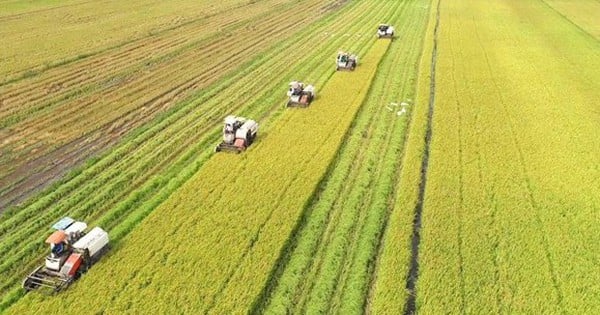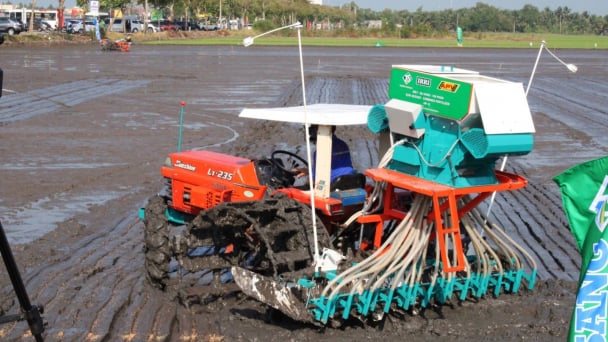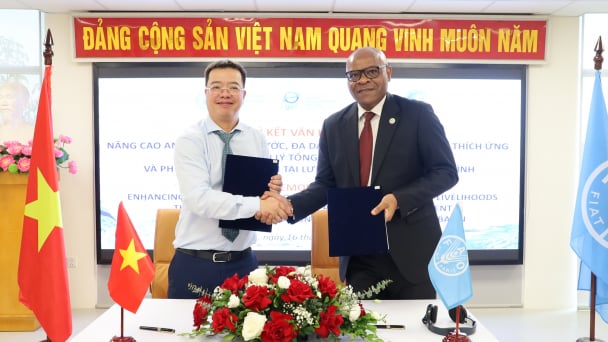May 20, 2025 | 18:18 GMT +7
May 20, 2025 | 18:18 GMT +7
Hotline: 0913.378.918
May 20, 2025 | 18:18 GMT +7
Hotline: 0913.378.918

In Yen Bai province, forest owners are now issued plantation codes by the Provincial Forest Protection Department. Photo: Bao Thang.
After several days of participating in training sessions organized by the Provincial Forest Protection Department and completing the inventory and reporting of forest conditions on the iTwood system, Mr. Me Van Giao from Dai Dong commune, Yen Binh district, became one of the first family forest owners in Yen Bai province to receive a plantation code.
“I’m so happy; now I can be completely assured about all the legal procedures related to timber,” he shared. Mr. Giao added that after the acacia and Melia tree plantation received its code, he plans to register for codes for the remaining family plots scattered across Yen Binh district.
Before these forests were “named” (as he puts it), he manually monitored and updated records. As plantation cycles last around six years, every few years, he and his children would traverse the forest to take notes before completing the procedures for sale.
Now, everything is much simpler. Even if Mr. Giao spends a month in Hanoi, he can still track whether his forest plots are nearing harvest age. His wrinkled eyes, at over 70 years old, gleamed with joy.
About 30 kilometers from Mr. Giao's home, Mr. Nguyen Van Bui from Tan Huong commune shared in the same excitement. Having struggled with managing many fragmented forest plots, he eagerly sought plantation codes as soon as he heard about the program.
“In recent years, Yen Bai has been focusing on forest development with many programs to promote policies and support the people. I believe that with these codes, plantation timber will fetch better prices,” Mr. Bùi said.
Besides Dai Dong and Tan Huong, two other communes in Yen Binh district, Phu Thinh and Thinh Hung, are also part of the pilot program to assign plantation codes. This program is implemented by the Forestry Department in collaboration with the Yen Bai Department of Agriculture and Rural Development and the Vietnam Academy of Forest Science, following Decision 2260 by the Ministry of Agriculture and Rural Development, which provides interim guidelines for assigning and managing plantation codes for raw material forests.
The pilot project is set to run for 24 months across five provinces, including Yen Bai. After more than four months of implementation, the program has established a database foundation for plantation areas, with over 16,000 hectares of forests registered for codes. Of these, 3,350 hectares have been verified and assigned plantation codes.

Yen Bai is one of the provinces with the highest forest coverage rates in the country. Photo: Bao Thang.
In Yen Bai province alone, over 600 hectares of forest have been registered for plantation codes. Of these, 304 hectares have been verified and assigned codes, with a total of 321 codes issued. The plantation codes have primarily been assigned to key tree species such as cinnamon, hybrid acacia, acacia mangium, eucalyptus, and melia. These are also the main types of trees cultivated in the province.
Mr. Kieu Tu Giang, Head of the Yen Bai Forest Protection Department, emphasized that assigning plantation codes promotes "transparency and openness" for forest growers. After several discussions with local authorities, the department collaborated to organize three training sessions on using the iTwood system for department staff, forest rangers, commune-level People's Committees in pilot areas, and local farmers' associations.
Recognizing that assigning plantation codes benefits the community by enhancing the legality of timber within supply chains, the Yen Bai Forest Protection Department has actively conducted outreach programs to guide family forest owners in registering accounts on the iTwood system.
"About 45% of Yen Bai’s forests are managed by commune-level People's Committees. Assigning plantation codes is essential, as it helps residents develop specialized forestry production zones and create links between forest-growing households and businesses,” Mr. Giang stated.
According to the Forestry Department's statistics, Vietnam currently has approximately 4 million hectares of plantation forests, supplying 35-40 million cubic meters of timber annually. This is a crucial resource for the wood processing and manufacturing industry.
"Assigning plantation codes is a vital task for the forestry sector. It is a strategic step toward increasing transparency about plantation origins and meeting timber traceability requirements, particularly as Vietnam integrates more deeply into the global timber and wood product supply chain,” said Mr. Nguyen Tuan Hung, Head of the Processing and Trade of Forestry Products Department.
Expanding on the purpose of the plantation code initiative, Mr. Hung stated a goal of assigning codes to approximately 25,000 hectares of raw material forests. The targeted beneficiaries include all forest owners defined under Article 8 of the Forestry Law, as well as related organizations and individuals.
According to materials prepared by the Forestry Department, the task of assigning plantation codes for raw material forests is delegated to provincial Forest Protection Departments. These departments are also responsible for managing the codes. Additionally, they collaborate with local governments, residents, and relevant organizations to monitor and supervise code usage. They maintain a registry and records of issued codes for long-term use in managing and tracing the origins of timber and forest products.
"Plantation codes are the foundation stones for digitizing and building an information database on local forest resources. They help identify plantation plots (sub-compartments, compartments, plots, central coordinates) linked to the forest owner's identity and land-use rights," Mr. Hung emphasized.

Mr. Hoang Lien Son shares the benefits of assigning plantation codes. Photo: Bao Thang.
The Forest Economics Research Center (under the Vietnam Academy of Forest Sciences), the agency responsible for developing the iTwood system for assigning codes to forest planting areas, specifies that the structure of raw material forest planting area codes is as follows: FAC.84.AA.YYYY-XXXXXX.
FAC is a fixed identifier, abbreviated from "Forest Area Code," representing the assigned raw material forest planting area code. 84 is Vietnam’s country code. The following components are: AA, the local code, as specified in Appendix 1 of Circular No. 07/2016/TT-BCA issued by the Ministry of Public Security on February 1, 2016; YYYY: The year the forest planting area code is assigned; XXXXXX: The sequential number of the application for the forest planting area code issued by the relevant authority.
For example, a forest planting area code such as FAC.84.08.2024-000001 can be understood as follows: This code was assigned to a forest area in Tuyen Quang Province in the year 2024 with the application serial number 000001.
Mr. Hoang Lien Son, Director of the Forest Economics Research Center, explained that there are currently three steps for an organization or individual to obtain a code. The forest owner provides details, including information about the forest owner, documentation of land use rights (certified by the commune-level People's Committee), information about the location of the planting area, information on the current forest status.
The code-issuing agency (the Provincial Forest Protection Sub-Department) will conduct a synchronized review and verification of the provided information, integrating it into the database. This includes adding the central coordinates (XY) and boundary coordinates of the forest planting area, linked to the forest owner's land use rights, as conducted by District Forest Protection Stations. Following this, a verification report on the forest planting area registration for code issuance will be finalized with the participation of the forest owner, the commune-level People's Committee, local forest rangers, and the District Forest Protection Station. Once the required documentation and information are complete, the Provincial Forest Protection Sub-Department will issue the forest planting area code.
Alongside the process of issuing forest planting area codes, a mechanism for revoking these codes is also in place for the reasons of: the request of the forest owner upon harvesting the forest plot, the forest owner's proposal when the forest plot is affected by natural disasters or pests, when the code is found to have been misused or fails to meet requirements during inspections.
Translated by Kieu Chi

(VAN) In 2024, over 295 million people across 53 countries and territories faced acute hunger—an increase of almost 14 million people compared to 2023, while the number of people facing catastrophic levels of hunger reached a record high.

(VAN) World Environment Day 2025 (June 5) carries the theme 'Beat Plastic Pollution' continuing to emphasize the global urgency of addressing the plastic waste crisis.

(VAN) This was the assessment shared by experts at the workshop titled 'Assessing the Role and Potential of Low-Emission Rice Production Systems in Vietnam,' held on the morning of May 19.

(VAN) Cai Rong Port is the fisheries control center of Quang Ninh, helping to monitor fishing vessels, combat IUU fishing, and remove the EC's 'yellow card'.

(VAN) The German Agricultural Society (DLG) explores the possibility of establishing a mechanization service center in Vietnam’s Mekong Delta to support farmers in accessing and utilizing advanced machinery.

(VAN) On May 16, the Department of Water Resources Management, in collaboration with the Food and Agriculture Organization of the United Nations (FAO), held a signing ceremony for the GEF-8 project document.

(VAN) Food safety, mechanization, vocational training, and market opening are key areas of cooperation expected between the Vietnamese Government and the Federal Republic of Germany.